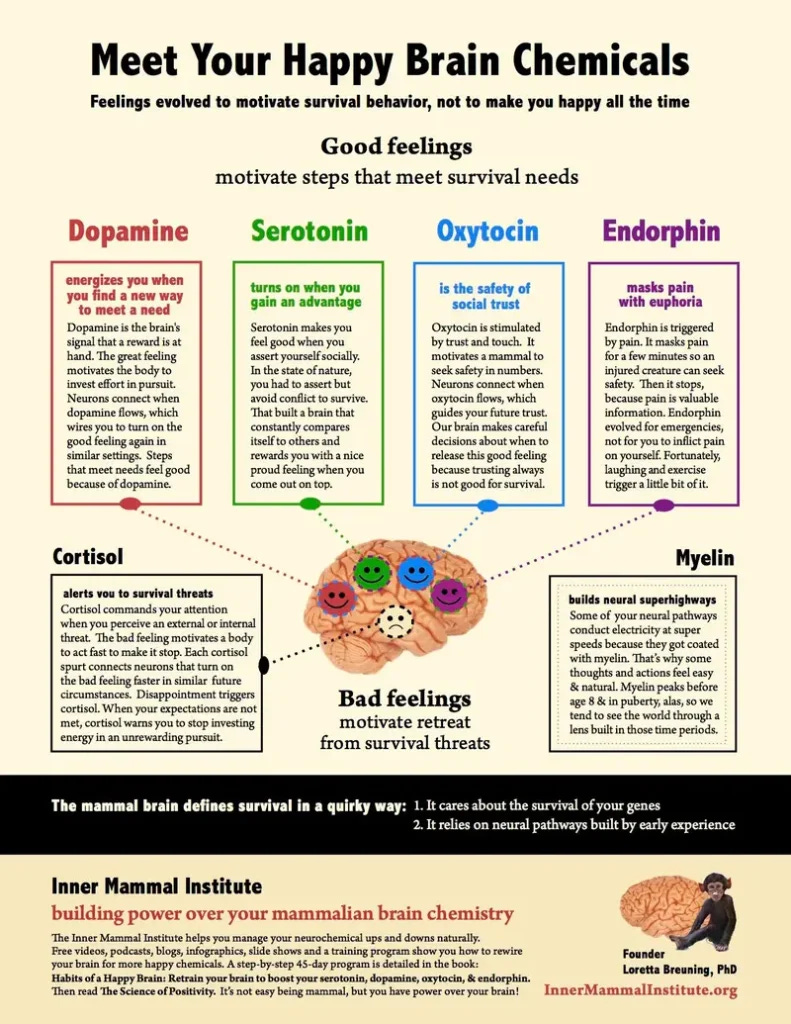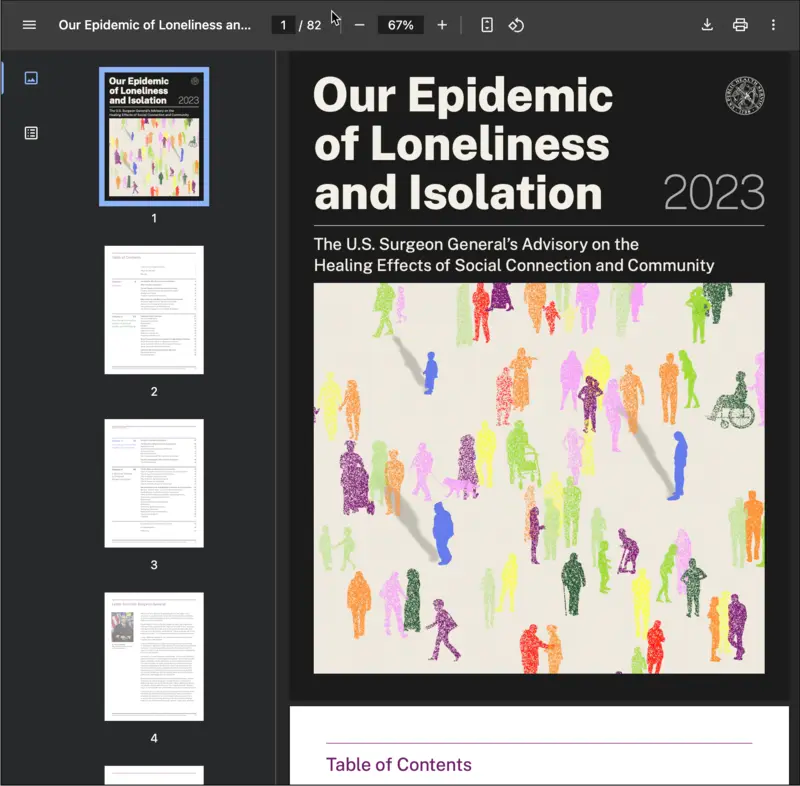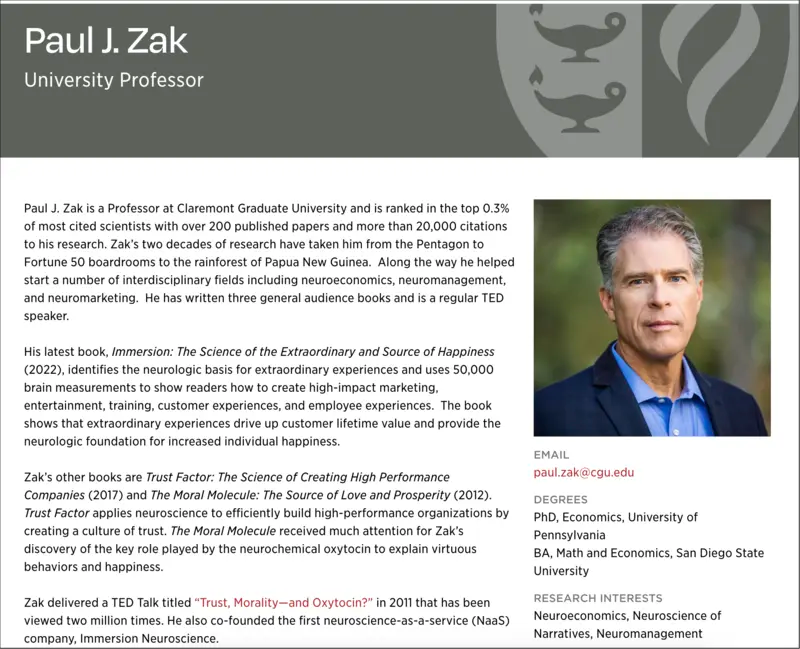Why Oxytocin = The New Dopamine.
The Trust Molecule: Why Oxytocin, Not Dopamine, Will Define the AI Era. (And What This Means For YOU & Your Business.)
Subscribe to The Digital Contrarian
“Strategic Insights for Digital Entrepreneurs Who Think Differently.”
I’m writing to you from the seat you see here in a hotel room just outside of Boston.
It’s Memorial Day weekend, and my family and I are here for my oldest son’s soccer tournament.
(We dropped the first game earlier today – and now the kids are out with Tylene, getting some downtime between games.)
I stayed back with Blue (our chihuahua and my occasional newsletter assistant), who’s “naked” (i.e. sans pink harness) and currently curled up beside me as I type this.
And while we’re here for soccer, I’ve been using this in-between time to dive deeper into the ideas I’m developing for my next book, The Return to Real.
One of the themes I’ve been most excited to explore is something that’s fascinated me for decades – dating back to when I studied neuroscience at Brown University.
It’s this:
In a world built around dopamine – oxytocin might just be the brain molecule that matters most.
So today, I want to share with you one of the (perhaps) more contrarian arguments from the book-in-progress:
1 | The Oxytocin Edge.
Over the past decade, dopamine has stolen the spotlight.
It’s the neurotransmitter behind our smartphone addictions, endless scrolling, and compulsive craving for novelty.
Books like Dopamine Nation (which we explored in [Issue #035]: Why the Struggle is the Solution) have made it clear:
Dopamine has shaped the modern world – and not always for the better.
But as we move deeper into the AI era, I believe the next great competitive advantage in both life and business won’t come from dopamine – it will come from oxytocin.
Oxytocin, often labeled the “love hormone,” is more accurately the neurotransmitter of trust, human connection, and social bonding.
While dopamine fuels the chase, oxytocin builds the bond.
It’s what turns fleeting interactions into lasting relationships – what transforms customers into communities, audiences into advocates, and employees into mission-driven allies.
And in a world increasingly run by AI, algorithms, and abstraction, that kind of bond is becoming rare.
And as we explored in [Issue #027]: Your Strategic Content Ecosystem – What’s increasingly rare will become increasingly valuable.
And this shift matters.
Because as digital interactions become cheaper, faster, and more artificial, the businesses that win will be the ones that feel the most real.
And real is where oxytocin lives.
The bottom line?
If dopamine is about getting attention, oxytocin is about earning trust. And the future belongs to those who understand the difference.
In other words…
Move over dopamine. There is a new neurotransmitter in town.
Let me explain…
2 | The Neurochemical Landscape.
We are, at our core, chemistry in motion.
Every decision we make, every craving we chase, every moment of connection or conflict – we can trace it back to the interplay of a few key molecules in the brain.
Four “happiness chemicals” in particular, shape much of our internal experience:
Dopamine – fuels anticipation, desire, and motivation. It’s what drives you to open that app, chase that deal, or refresh your inbox.
Serotonin – governs mood, status, and feelings of belonging. It’s tied to self-respect, confidence, and how we perceive our place in the social hierarchy.
Endorphins – the body’s natural painkillers. Released through laughter, exercise, and even crying, they create feelings of pleasure and relief, especially in response to stress or physical exertion.
Oxytocin – the molecule of trust, bonding, and connection. Released through eye contact, physical touch, shared experiences, and emotional intimacy.

What’s easy to forget is this: we’re essentially physical bodies chasing neurochemicals.
Not metaphorically.
But literally.
We seek the behaviors and environments that flood our systems with the right mix of these feel-good messengers – often without even realizing it.
And this is where oxytocin stands apart.
Unlike dopamine – which can be triggered by something as shallow as a push notification – oxytocin typically requires presence. Physicality. Proximity.
It’s released through a hug. Through eye contact. Through a warm, meaningful conversation without a screen between you.
That’s probably why, as I sit in this hotel room writing between soccer games this Memorial Day weekend, my chihuahua Blue is curled up in her bed next to me.
One little deep-sniff snuggle break with her mid-paragraph?
Oxytocin hit.
We use pets the way our nervous system intended – as oxytocin delivery devices.
Not because they’re productive. Not because they help us get more done. But because they are effective at satisfying our neurochemical cravings.
(And in this respect, pets are in many ways a proxy for people.)
This is more than sentimental biology. It’s a neurological need. And the further our “AI-First World” drifts into digital abstraction, the more acute that need becomes.
So what happens when a society is low on oxytocin?
3 | The Global Oxytocin Deficit.
As we first explored together in [Issue #028] The “Return to Real” Movement – we live in a world that’s never been more connected – and yet we’ve never felt more alone.
It’s a paradox we’ve all felt but struggled to name.
More messages, more content, more notifications… yet somehow, less meaning. Less trust. Less real connection.
This is the Global Oxytocin Deficit.
Trust in institutions is at historic lows. In fact, according to the 2025 Edelman Trust Barometer, trust in government, media, NGOs and employers has dropped across nearly every demographic.
Interpersonal trust isn’t faring much better.
Loneliness has reached epidemic levels.
In fact, former Surgeon General Dr. Vivek Murthy named loneliness a “public health crisis” back in 2023 – and the data since then has only reinforced his warning.
The fact is this:
We’ve spent the last decade optimizing for dopamine: clicks, likes, swipes, streams.
But those metrics can’t measure trust.
And unlike dopamine, oxytocin can’t be mass-produced. It doesn’t surge in response to a headline or a sale. It’s not elicited by content volume – it’s triggered by presence. Intimacy. Safety. Shared space.
Which is precisely what we’ve lost.
The digital migration of nearly every form of communication – text over talk, Zoom over rooms, A.I. over H.I. – has stripped interaction down to its most efficient, but least embodied form.
And efficiency kills oxytocin.
In-person meetings, physical touch, unstructured time together: these are the substrates oxytocin needs to thrive. But we’ve designed those moments out of our lives.
(And AI is only accelerating this trend.)
To be clear, this isn’t about going “anti-digital.” Virtual interactions can foster real bonds. In some contexts, they’ve kept people alive and connected.
But the neurochemical truth is this: the further we abstract ourselves from real human contact, the more we starve the systems that regulate trust and connection.
So when we say the world is “disconnected,” what we’re often really saying is:
We’re running low on oxytocin.
And in that light, the strategic imperative becomes clearer:
If you’re building a brand, a business, a culture, or a community – you should be building for oxytocin.
4 | The Business Case for Oxytocin.
In a world where speed and scale have become default virtues, trust is now the scarcest – and thus most valuable – commodity.
And trust is oxytocin’s domain.
While dopamine may spike clicks, drive conversions, and fuel engagement loops, oxytocin is what builds brand loyalty, deepens customer relationships, and keeps people coming back – not because they have to, but because they want to.
This isn’t just a feel-good idea. It’s grounded in biology.
Dr. Paul Zak, one of the leading researchers on the neuroscience of trust, has shown that higher levels of oxytocin in the brain correlate with increased generosity, empathy, and cooperative behavior.
In one study1, participants who received an oxytocin boost were 80% more likely to share money with a stranger than those who didn’t.
1 Paul J. Zak, Angela A. Stanton, and Sheila Ahmadi, “Oxytocin Increases Generosity in Humans,” PLoS ONE 2, no. 11 (2007): e1128, https://doi.org/10.1371/journal.pone.0001128
In a business context, this translates to higher retention, more word-of-mouth referrals, more resilience during downturns, and more aligned internal cultures.
Companies like Patagonia, Zappos, and Chick-fil-A have built empires not by hacking attention – but by strategically cultivating trust.
Patagonia asked customers not to buy its products in its famous full-page ad, Zappos trained support reps to stay on the phone as long as it takes (even 10 hours), and Chick-fil-A’s local operator model makes each location feel like a community fixture – not just a fast-food chain – with it’s now-famous tagline: “My pleasure.“
Patagonia’s now-famous 2011 full-page ad in the New York Times imploring its customers “Don’t Buy This Jacket.”
In their own way, each has chosen human-first systems that generate loyalty not just through dopamine jolts – but through sustained, oxytocin-rich connection and customer loyalty.
So how do *we* do that?
(And by “we” I mean small business owners, like you and me…)
Well, it begins by understanding that the customer journey is not just a funnel – it’s a Trust Arc.
Every moment – whether automated or live, digital or analog- is an opportunity to either erode or elevate oxytocin.
And here’s the caution:
Beware of the reductionist trap.
It’s tempting to think of neurochemicals as simple levers we can pull: Add dopamine here, sprinkle in some oxytocin there, and voilà – customer for life.
But humans aren’t robots, and trust can’t be manufactured on command.
One of the most profound illustrations of this truth comes from the famous Harlow monkey experiments of the 1950s2:
Infant monkeys were given a choice: spend time with a cold, metal “mother” that provided milk – or a soft, cloth “mother” that provided no food. Overwhelmingly, the monkeys chose comfort over utility.
2 Harlow H. F., Dodsworth R. O., & Harlow M. K. (1965). Total social isolation in monkeys. Proceedings of the National Academy of Sciences of the United States of America. Retrieved from https://www.ncbi.nlm.nih.gov/pmc/articles/PMC285801/pdf/pnas00159-0105.pdf
In other words…
They chose oxytocin.
And therein lies the opportunity:
Because what if many of our modern maladies – loneliness, burnout, distrust, polarization – aren’t just social or political problems?
What if they’re biochemical symptoms of a society running low on oxytocin?
Well, what that might mean is as entrepreneurs – in this Return to Real Movement taking shape in the world – we have an opportunity to fill this void.
5 | How to Strategically Elicit Oxytocin.
If oxytocin is the molecule of trust – and trust is the new currency – then the natural next question becomes:
How do we earn it?
Or more precisely:
How do we create the conditions where oxytocin can actually be released – in our customers, our readers, our teams, and ourselves?
Well, here are at least three (3) strategies rooted in biology, backed by research, and immediately applicable – especially for those of us building small, intentional businesses that we can begin considering more deeply:
1. Lead with Personalization (The Right Kind)
We often think personalization means inserting someone’s name in a subject line. Or using AI to create “personalized automation at scale” – But true oxytocin-releasing personalization goes deeper.
Oxytocin trigger: Feeling seen, understood, and valued.
Action: Send a thoughtful voice memo (can’t be faked) or personal email reply. Reference a personal detail someone shared in conversation, like a kiddo’s name or their recent move.
Why it matters: Neuroscience shows that oxytocin is tied to feeling safe and known. When your customers feel like you “get” them, trust compounds.
Study: Zak (2015) found that emotionally engaging narratives significantly raise oxytocin levels, increasing trust and cooperative behavior.3
3 Zak, Paul J. (2015). Why inspiring stories make us react: The neuroscience of narrative. Cerebrum: The Dana Forum on Brain Science, 2015, cer-08-15. Available at: https://www.ncbi.nlm.nih.gov/pmc/articles/PMC4445577/
2. Prioritize *Strategic* In-Person Moments
Human beings evolved for face-to-face connection. And no technology – not video calls, not AI chatbots, not photorealistic avatars – comes close to replicating the chemical richness of a real-life encounter (from pheromone release to posture recognition).
Oxytocin trigger: Eye contact. Synchronized body language. Physical presence.
Action: Host a customer dinner. Invite clients to a retreat. (e.g. I’ve already started planning several in-person gatherings tied to my upcoming book launch with this very idea in mind.)
Why it matters: In-person interactions build emotional memory and imprint loyalty in ways no funnel or automation ever could.
Study: A classic study by Bos et al. compared four modes of interaction: face-to-face, video, audio, and text – in a trust-based game. Groups who met in person cooperated more quickly and reached higher trust levels than text-based groups. Even video lagged slightly behind in-person. (Text performed worst.)4
4 Bos, Nathan, et al. (2002). Collaboration and trust in virtual teams: Theory and evidence. Proceedings of the 2002 ACM Conference on Computer Supported Cooperative Work (CSCW ’02), pp. 135–140. Association for Computing Machinery. Available at: https://dl.acm.org/doi/10.1145/587078.587100
3. Craft Stories, Not Just Messages.
Interestingly, Oxytocin is released not just through touch – but also through story. Especially stories that create emotional tension and resolution.
Oxytocin trigger: Narrative empathy. Emotional arcs.
Action: Don’t just share case studies – share customer journeys. Don’t just explain a point – tell your audience about a moment that made you feel it.
Why it matters: Stories activate mirror neurons and foster emotional connection, both prerequisites for oxytocin release.
Study: Dr. Jorge Barraza’s storytelling experiments (2015) demonstrated that emotionally resonant stories increased oxytocin levels – and directly predicted increased generosity and action-taking.5
5 Barraza, J. A., Alexander, V., Beavin, L. E., Terris, E. T., & Zak, P. J. (2015). The heart of the story: Peripheral physiology during narrative exposure predicts charitable giving. Biological Psychology, 105, 138–143. Available at: https://pubmed.ncbi.nlm.nih.gov/25617658/
Now, these strategies aren’t necessarily complex. But they do require intention.
Because we’ve built a world that optimizes for dopamine.
Quick hits. High speed. Shiny rewards.
To build for oxytocin means choosing a slower path. A more human one.
But as we’ve explored, it’s the path that leads somewhere real…
And as we first explored in [Issue #020]: Going Analog: The Ultimate Zig? – it’s one of the last true paths for building a moat around your business.
6 | The Oxytocin Paradox.
But here’s the part they don’t tell you.
Oxytocin isn’t always warm and fuzzy. While it’s often described as the “love hormone” or the “trust molecule,” its effects are more complex – and occasionally, more dangerous.
Yes, oxytocin fosters empathy, bonding, and prosocial behavior.
But it also strengthens in-group loyalty – sometimes at the expense of the “other.”
A 2011 study published in PNAS found that oxytocin can increase ethnocentrism – the tendency to favor your own group and distrust outsiders.6
6 De Dreu, C. K. W., Greer, L. L., Van Kleef, G. A., Shalvi, S., & Handgraaf, M. J. J. (2011). Oxytocin promotes human ethnocentrism. Proceedings of the National Academy of Sciences, 108(4), 1262–1266. Available at: https://www.pnas.org/doi/10.1073/pnas.1015316108
Participants dosed with oxytocin were more likely to sacrifice out-group members in moral dilemmas to protect their in-group.
The takeaway?
Oxytocin can unite – but it can also divide.
And in a polarized world, that matters.
(In a business context, for example, as your competition further entrenches itself by uniting its customers with in-person gatherings, *you* and your business becomes part of “the other”.)
There’s another paradox, too:
Oxytocin can’t be hacked.
As we explored in [Issue #048]: Truth. Hell. & The “Lie” The Believe – one of the core, contrarian principles of The Return to Real is “The Best Things in Life Don’t Scale” – like for example, a warm hug from one your kids or grandkids.
Oxytocin resists efficiency.
It defies automation.
And that’s both the challenge – and the opportunity.
“Because when something becomes hard to fake, it becomes easier to trust.”
And in a world of AI-generated everything, what’s trusted becomes what’s valued.
Which brings us full circle in our discussion today:
The Oxytocin Edge isn’t just a feel-good advantage. It’s a competitive moat – one built not from code or capital, but from care and connection.
And that’s what makes it so rare – while at the same time, a contrarian strategy that’s accessible to all of us – including you.
7 | Closing: A Soccer Game & A Reminder.
We’ve covered a lot of ground in this issue – from neurotransmitters to business strategy, from trust games to monkey studies.
But at the core, the message is simple:
Build for oxytocin.
In your business. In your life. In your relationships.
Because in a world obsessed with dopamine – oxytocin is the real edge.
Now, I’ve got another soccer game to catch this afternoon. My son is back on the field soon, and I want to be there – fully present – to give him a fist-bump before game time…
…And to give him a warm pat on the shoulder after the game – win or lose.
So I’ll wrap this issue here.
Have a great rest of your day.
And remember to hug the ones you love.
After all – Do it for the oxytocin ;-)
Until next week,
Ryan









